Arindam Mitra
Explorer: Scaling Exploration-driven Web Trajectory Synthesis for Multimodal Web Agents
Feb 19, 2025Abstract:Recent success in large multimodal models (LMMs) has sparked promising applications of agents capable of autonomously completing complex web tasks. While open-source LMM agents have made significant advances in offline evaluation benchmarks, their performance still falls substantially short of human-level capabilities in more realistic online settings. A key bottleneck is the lack of diverse and large-scale trajectory-level datasets across various domains, which are expensive to collect. In this paper, we address this challenge by developing a scalable recipe to synthesize the largest and most diverse trajectory-level dataset to date, containing over 94K successful multimodal web trajectories, spanning 49K unique URLs, 720K screenshots, and 33M web elements. In particular, we leverage extensive web exploration and refinement to obtain diverse task intents. The average cost is 28 cents per successful trajectory, making it affordable to a wide range of users in the community. Leveraging this dataset, we train Explorer, a multimodal web agent, and demonstrate strong performance on both offline and online web agent benchmarks such as Mind2Web-Live, Multimodal-Mind2Web, and MiniWob++. Additionally, our experiments highlight data scaling as a key driver for improving web agent capabilities. We hope this study makes state-of-the-art LMM-based agent research at a larger scale more accessible.
Step-by-Step Reasoning to Solve Grid Puzzles: Where do LLMs Falter?
Jul 20, 2024Abstract:Solving grid puzzles involves a significant amount of logical reasoning. Hence, it is a good domain to evaluate the reasoning capability of a model which can then guide us to improve the reasoning ability of models. However, most existing works evaluate only the final predicted answer of a puzzle, without delving into an in-depth analysis of the LLMs' reasoning chains (such as where they falter) or providing any finer metrics to evaluate them. Since LLMs may rely on simple heuristics or artifacts to predict the final answer, it is crucial to evaluate the generated reasoning chain beyond overall correctness measures, for accurately evaluating the reasoning abilities of LLMs. To this end, we first develop GridPuzzle, an evaluation dataset comprising 274 grid-based puzzles with different complexities. Second, we propose a new error taxonomy derived from manual analysis of reasoning chains from LLMs including GPT-4, Claude-3, Gemini, Mistral, and Llama-2. Then, we develop an LLM-based framework for large-scale subjective evaluation (i.e., identifying errors) and an objective metric, PuzzleEval, to evaluate the correctness of reasoning chains. Evaluating reasoning chains from LLMs leads to several interesting findings. We further show that existing prompting methods used for enhancing models' reasoning abilities do not improve performance on GridPuzzle. This highlights the importance of understanding fine-grained errors and presents a challenge for future research to enhance LLMs' puzzle-solving abilities by developing methods that address these errors. Data and source code are available at https://github.com/Mihir3009/GridPuzzle.
sPhinX: Sample Efficient Multilingual Instruction Fine-Tuning Through N-shot Guided Prompting
Jul 16, 2024Abstract:Despite the remarkable success of LLMs in English, there is a significant gap in performance in non-English languages. In order to address this, we introduce a novel recipe for creating a multilingual synthetic instruction tuning dataset, sPhinX, which is created by selectively translating instruction response pairs from English into 50 languages. We test the effectiveness of sPhinX by using it to fine-tune two state-of-the-art models, Phi-3-small and Mistral-7B and then evaluating them across a comprehensive suite of multilingual benchmarks that test reasoning, question answering, and reading comprehension. Our results show that Phi-3-small and Mistral-7B fine-tuned with sPhinX perform better on an average by 4.2%pt and 5%pt respectively as compared to the baselines. We also devise a strategy to incorporate N-shot examples in each fine-tuning sample which further boosts the performance of these models by 3%pt and 10%pt respectively. Additionally, sPhinX also outperforms other multilingual instruction tuning datasets on the same benchmarks along with being sample efficient and diverse, thereby reducing dataset creation costs. Additionally, instruction tuning with sPhinX does not lead to regression on most standard LLM benchmarks.
AgentInstruct: Toward Generative Teaching with Agentic Flows
Jul 03, 2024



Abstract:Synthetic data is becoming increasingly important for accelerating the development of language models, both large and small. Despite several successful use cases, researchers also raised concerns around model collapse and drawbacks of imitating other models. This discrepancy can be attributed to the fact that synthetic data varies in quality and diversity. Effective use of synthetic data usually requires significant human effort in curating the data. We focus on using synthetic data for post-training, specifically creating data by powerful models to teach a new skill or behavior to another model, we refer to this setting as Generative Teaching. We introduce AgentInstruct, an extensible agentic framework for automatically creating large amounts of diverse and high-quality synthetic data. AgentInstruct can create both the prompts and responses, using only raw data sources like text documents and code files as seeds. We demonstrate the utility of AgentInstruct by creating a post training dataset of 25M pairs to teach language models different skills, such as text editing, creative writing, tool usage, coding, reading comprehension, etc. The dataset can be used for instruction tuning of any base model. We post-train Mistral-7b with the data. When comparing the resulting model Orca-3 to Mistral-7b-Instruct (which uses the same base model), we observe significant improvements across many benchmarks. For example, 40% improvement on AGIEval, 19% improvement on MMLU, 54% improvement on GSM8K, 38% improvement on BBH and 45% improvement on AlpacaEval. Additionally, it consistently outperforms other models such as LLAMA-8B-instruct and GPT-3.5-turbo.
Phi-3 Technical Report: A Highly Capable Language Model Locally on Your Phone
Apr 23, 2024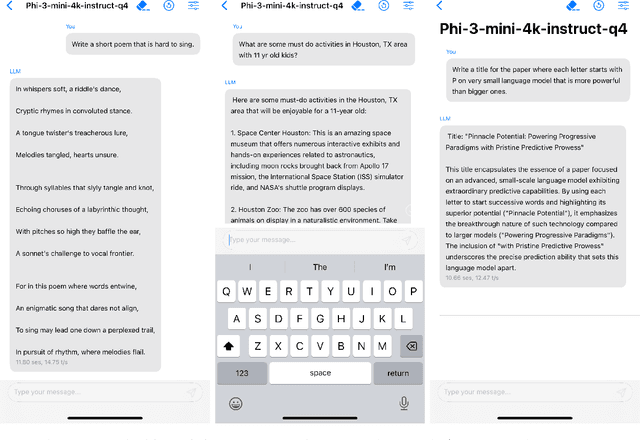

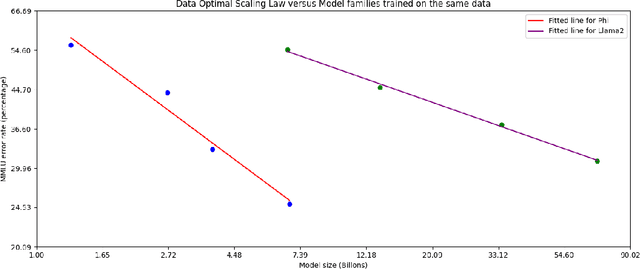
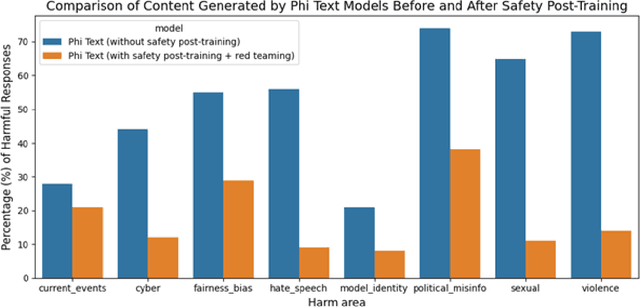
Abstract:We introduce phi-3-mini, a 3.8 billion parameter language model trained on 3.3 trillion tokens, whose overall performance, as measured by both academic benchmarks and internal testing, rivals that of models such as Mixtral 8x7B and GPT-3.5 (e.g., phi-3-mini achieves 69% on MMLU and 8.38 on MT-bench), despite being small enough to be deployed on a phone. The innovation lies entirely in our dataset for training, a scaled-up version of the one used for phi-2, composed of heavily filtered web data and synthetic data. The model is also further aligned for robustness, safety, and chat format. We also provide some initial parameter-scaling results with a 7B and 14B models trained for 4.8T tokens, called phi-3-small and phi-3-medium, both significantly more capable than phi-3-mini (e.g., respectively 75% and 78% on MMLU, and 8.7 and 8.9 on MT-bench).
Towards Systematic Evaluation of Logical Reasoning Ability of Large Language Models
Apr 23, 2024Abstract:Recently developed large language models (LLMs) have been shown to perform remarkably well on a wide range of language understanding tasks. But, can they really "reason" over the natural language? This question has been receiving significant research attention and many reasoning skills such as commonsense, numerical, and qualitative have been studied. However, the crucial skill pertaining to 'logical reasoning' has remained underexplored. Existing work investigating this reasoning ability of LLMs has focused only on a couple of inference rules (such as modus ponens and modus tollens) of propositional and first-order logic. Addressing the above limitation, we comprehensively evaluate the logical reasoning ability of LLMs on 25 different reasoning patterns spanning over propositional, first-order, and non-monotonic logics. To enable systematic evaluation, we introduce LogicBench, a natural language question-answering dataset focusing on the use of a single inference rule. We conduct detailed analysis with a range of LLMs such as GPT-4, ChatGPT, Gemini, Llama-2, and Mistral using chain-of-thought prompting. Experimental results show that existing LLMs do not fare well on LogicBench; especially, they struggle with instances involving complex reasoning and negations. Furthermore, they sometimes overlook contextual information necessary for reasoning to arrive at the correct conclusion. We believe that our work and findings facilitate future research for evaluating and enhancing the logical reasoning ability of LLMs. Data and code are available at https://github.com/Mihir3009/LogicBench.
Direct Nash Optimization: Teaching Language Models to Self-Improve with General Preferences
Apr 04, 2024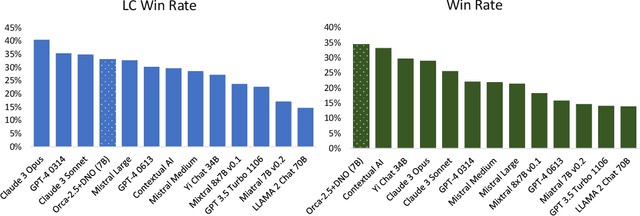
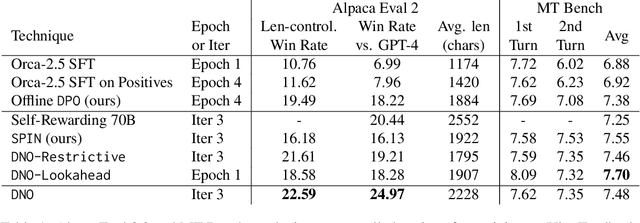
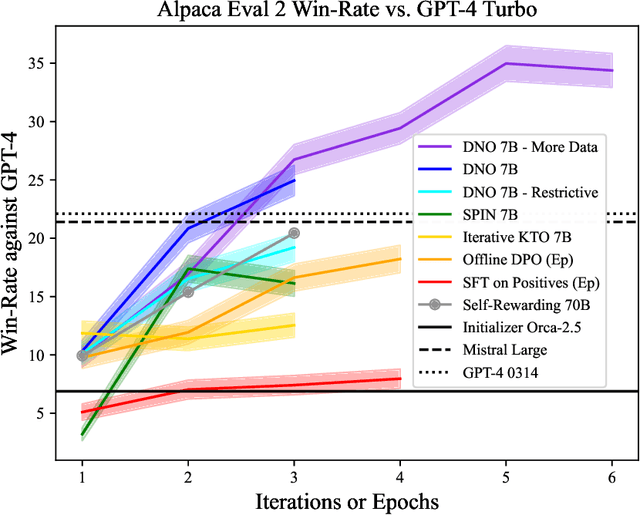

Abstract:This paper studies post-training large language models (LLMs) using preference feedback from a powerful oracle to help a model iteratively improve over itself. The typical approach for post-training LLMs involves Reinforcement Learning from Human Feedback (RLHF), which traditionally separates reward learning and subsequent policy optimization. However, such a reward maximization approach is limited by the nature of "point-wise" rewards (such as Bradley-Terry model), which fails to express complex intransitive or cyclic preference relations. While advances on RLHF show reward learning and policy optimization can be merged into a single contrastive objective for stability, they yet still remain tethered to the reward maximization framework. Recently, a new wave of research sidesteps the reward maximization presumptions in favor of directly optimizing over "pair-wise" or general preferences. In this paper, we introduce Direct Nash Optimization (DNO), a provable and scalable algorithm that marries the simplicity and stability of contrastive learning with theoretical generality from optimizing general preferences. Because DNO is a batched on-policy algorithm using a regression-based objective, its implementation is straightforward and efficient. Moreover, DNO enjoys monotonic improvement across iterations that help it improve even over a strong teacher (such as GPT-4). In our experiments, a resulting 7B parameter Orca-2.5 model aligned by DNO achieves the state-of-the-art win-rate against GPT-4-Turbo of 33% on AlpacaEval 2.0 (even after controlling for response length), an absolute gain of 26% (7% to 33%) over the initializing model. It outperforms models with far more parameters, including Mistral Large, Self-Rewarding LM (70B parameters), and older versions of GPT-4.
Orca-Math: Unlocking the potential of SLMs in Grade School Math
Feb 16, 2024Abstract:Mathematical word problem-solving has long been recognized as a complex task for small language models (SLMs). A recent study hypothesized that the smallest model size, needed to achieve over 80% accuracy on the GSM8K benchmark, is 34 billion parameters. To reach this level of performance with smaller models, researcher often train SLMs to generate Python code or use tools to help avoid calculation errors. Additionally, they employ ensembling, where outputs of up to 100 model runs are combined to arrive at a more accurate result. Result selection is done using consensus, majority vote or a separate a verifier model used in conjunction with the SLM. Ensembling provides a substantial boost in accuracy but at a significant cost increase with multiple calls to the model (e.g., Phi-GSM uses top-48 to boost the performance from 68.2 to 81.5). In this work, we present Orca-Math, a 7-billion-parameter SLM based on the Mistral-7B, which achieves 86.81% on GSM8k without the need for multiple model calls or the use of verifiers, code execution or any other external tools. Our approach has the following key elements: (1) A high quality synthetic dataset of 200K math problems created using a multi-agent setup where agents collaborate to create the data, (2) An iterative learning techniques that enables the SLM to practice solving problems, receive feedback on its solutions and learn from preference pairs incorporating the SLM solutions and the feedback. When trained with Supervised Fine-Tuning alone, Orca-Math achieves 81.50% on GSM8k pass@1 metric. With iterative preference learning, Orca-Math achieves 86.81% pass@1. Orca-Math surpasses the performance of significantly larger models such as LLAMA-2-70B, WizardMath-70B, Gemini-Pro, ChatGPT-3.5. It also significantly outperforms other smaller models while using much smaller data (hundreds of thousands vs. millions of problems).
Orca 2: Teaching Small Language Models How to Reason
Nov 21, 2023



Abstract:Orca 1 learns from rich signals, such as explanation traces, allowing it to outperform conventional instruction-tuned models on benchmarks like BigBench Hard and AGIEval. In Orca 2, we continue exploring how improved training signals can enhance smaller LMs' reasoning abilities. Research on training small LMs has often relied on imitation learning to replicate the output of more capable models. We contend that excessive emphasis on imitation may restrict the potential of smaller models. We seek to teach small LMs to employ different solution strategies for different tasks, potentially different from the one used by the larger model. For example, while larger models might provide a direct answer to a complex task, smaller models may not have the same capacity. In Orca 2, we teach the model various reasoning techniques (step-by-step, recall then generate, recall-reason-generate, direct answer, etc.). More crucially, we aim to help the model learn to determine the most effective solution strategy for each task. We evaluate Orca 2 using a comprehensive set of 15 diverse benchmarks (corresponding to approximately 100 tasks and over 36,000 unique prompts). Orca 2 significantly surpasses models of similar size and attains performance levels similar or better to those of models 5-10x larger, as assessed on complex tasks that test advanced reasoning abilities in zero-shot settings. make Orca 2 weights publicly available at aka.ms/orca-lm to support research on the development, evaluation, and alignment of smaller LMs
Teaching Language Models to Hallucinate Less with Synthetic Tasks
Oct 10, 2023



Abstract:Large language models (LLMs) frequently hallucinate on abstractive summarization tasks such as document-based question-answering, meeting summarization, and clinical report generation, even though all necessary information is included in context. However, optimizing LLMs to hallucinate less on these tasks is challenging, as hallucination is hard to efficiently evaluate at each optimization step. In this work, we show that reducing hallucination on a synthetic task can also reduce hallucination on real-world downstream tasks. Our method, SynTra, first designs a synthetic task where hallucinations are easy to elicit and measure. It next optimizes the LLM's system message via prefix-tuning on the synthetic task, and finally transfers the system message to realistic, hard-to-optimize tasks. Across three realistic abstractive summarization tasks, SynTra reduces hallucination for two 13B-parameter LLMs using only a synthetic retrieval task for supervision. We also find that optimizing the system message rather than the model weights can be critical; fine-tuning the entire model on the synthetic task can counterintuitively increase hallucination. Overall, SynTra demonstrates that the extra flexibility of working with synthetic data can help mitigate undesired behaviors in practice.
 Add to Chrome
Add to Chrome Add to Firefox
Add to Firefox Add to Edge
Add to Edge